Pros
Cons
Introduction
The P7100 is available now in black, at an MSRP of $499.
Front
{{section_header}}{{section.name}}{{/section_header}}

Back
{{section_header}}{{section.name}}{{/section_header}}

Sides
{{section_header}}{{section.name}}{{/section_header}}

Top
{{section_header}}{{section.name}}{{/section_header}}

Bottom
{{section_header}}{{section.name}}{{/section_header}}

In the Box
{{section_header}}{{section.name}}{{/section_header}}

• Nikon Coolpix P7100 digital camera
• EN-EL14 rechargeable lithium-ion battery
• MH-24 wall-mounted battery charger
• mini-USB cable
• A/V cable
• shoulder strap
• software CD-ROM
• reference manual CD-ROM
• quick-start manual
• warranty
Color
{{section_header}}{{section.name}}{{/section_header}}
The P7100 reproduces reasonably accurate colors—not as true-to-life as most system and DSLR cameras or even lower-end point-and-shoots, but closer than its high-end peers.
Neutral proved to be the most accurate color mode, producing a minimum color error of 3.13 at 90% saturation. We like to see color error of 3.0 or less, and 90% is the very low end of what we consider to be acceptable saturation, but the overall score is decent. Most shades come close to the ideal coloring, but bright yellow is much greener and paler than it should be. That one sickly tone throws off the average. More on how we test color.
We're not sure why high-end compacts fail reproduce colors as faithfully as system cameras or even cheaper point-and-shoots, but it's almost always the case. So while the P7100's score is just average in the bigger picture, it's actually the most accurate high-end compact that we've tested. It scored slightly better than the Canon S100 or Fujifilm X10, and it's much more accurate than the Canon G12.
Color Modes
{{section_header}}{{section.name}}{{/section_header}}
Neutral is the most accurate default color mode. Standard, Vivid, and Monochrome presets are also included.
The best default setting, Neutral, is better than average for the advanced compact class. But like almost everything else on this camera, the P7100's color profiles are adjustable. In the Custom Picture Control menu, users can tweak the sharpening, contrast, and saturation of any existing color setting. Each preset profile can be adjusted, and the system accommodates two custom settings. That's more color control than most compacts offer.
The P7100 can also shoot RAW format photos, leaving it up to the user to process color by hand (or computer mouse, more accurately).
Noise
{{section_header}}{{section.name}}{{/section_header}}
Noise performance is generally strong. The P7100 is built around a 1/1.7" CCD sensor, about 40% larger than the sensors in typical point-and-shoots. That extra size helps the P7100 to deliver clean images throughout most of the ISO range. Up toward the higher settings, the processor adds a dose of noise reduction to keep noise levels in check, but shots retain a decent amount of detail without becoming too grainy. Our chief concern is that colors begin to lose their saturation around ISO 800. More on how we test noise.
Predictably, the P7100 shows less noise in bright light than in low light. We measured an average of just 0.9% noise across all ISO levels at 3000 lux, maxing out at 1.3%, and 1.04% noise at 60 lux with a maximum of 1.5%.
While the P7100 shows less noise than the Canon G12 or Fujifilm X10, the P7100 is arguably the worst performer in this comparison group, mainly because of the way it handles noise at the upper reaches of the ISO range. The two CMOS sensor-based cameras in the group (the Fujifilm X10 and Canon S100) hold more color and detail at their highest ISO settings than the P7100 does, even if the X10 allows more noise to stay in the final photo.
At the lower end of the ISO range, the P7100 performs very well, holding detail and color without scrubbing away much detail at all. So it should work as well, if not better, than most of its competitors in bright, outdoor situations, but it isn't an ideal indoor or low-light camera.
{{comparison_bars title="Noise Score Comparison", attribute="Noise Score", xLabel="Noise Score"}}
ISO
{{section_header}}{{section.name}}{{/section_header}}
The P7100's native ISO range stretches in full stops from 100 to 3200. The Hi 1 setting translates to ISO 6400, and while it's a full-resolution setting, Nikon does not consider it part of the P7100's native capabilities (so we didn't test it as such).
Resolution
{{section_header}}{{section.name}}{{/section_header}}
The P7100 resolves an excellent amount of detail for a compact camera. It produced some of the best sharpness and chromatic aberration results we've seen from any RAW-capable point-and-shoots out there (and we've tested all of the big ones at this point). Its poor distortion score drags down the overall score, unfortunately. More on how we test resolution.
Distortion ({{product.raw_scores['Distortion Score']}})
By default, the P7100 shoots wildly distorted photos. Our test JPEGs look like reflections of a funhouse mirror. All cameras suffer from distortion, and almost all of them automatically correct the problem with in-camera processing—but not the P7100. We measured a whopping 2.55% barrel distortion at the wide angle, and a still-obvious 1.58% and 1.27% pincushion effect at the mid-range and telephoto focal lengths, respectively.
The P7100 does offer in-camera distortion control, which straightens out the problem to where it's barely noticeable. But that option is turned off by default, and is only available in manual modes—any quick snapshots taken in auto mode will be warped considerably. Distortion can be fixed in Photoshop or RAW converter software, but that's a time consuming process—probably moreso than setting up a good shot in Program or Manual mode in the first place.
Sharpness ({{product.raw_scores['Sharpness Score']}})
Sharpness is great. We measured an average of about 1590 horizontal MTF50s and 1680 vertical MTF50s across the wide, middle, and telephoto focal lengths. That places the P7100 among sharpest shooters in the advanced compact class, ahead of the Canon G12 and Fujifilm X10, and a length behind the Canon S100 (as well as the Olympus XZ-1, not included in this comparison group).
We're sure that a great lens and sensor are behind the impressive sharpness score, but every camera gets a bit of help from its JPEG processor. That said, we noticed just a tiny hint of artificial pixel sharpening along some edges, most notably at the wide angle toward the periphery of the frame. It's subtle, and tastefully applied. Sharpening is also user-adjustable; we shot our test photos with the Neutral color mode (the most accurate), and sharpening is set to 2 by default (on a scale of 0 to 6)—there's room to fiddle with the intensity in both directions.
Chromatic Aberration ({{product.raw_scores['Chromatic Aberration Score']}})
The P7100 controls chromatic aberration very well. Faint, purplish discoloration appears around high-contrast areas at the edges of the frame at the wide angle and telephoto focal lengths, but we had to squint a bit to find those examples. The P7100's results are functionally identical to both the Fujifilm X10 and Canon S100, and notably better than the Canon G12.
Quality & Size Options
{{section_header}}{{section.name}}{{/section_header}}
One of the P7100's defining traits is RAW (uncompressed) image capture. RAW files can only be captured at the native 10.1-megapixel setting in a 4:3 (standard) aspect ratio. Of course, it also captures run-of-the-mill JPEGs in a variety of resolutions and aspect ratios, and at three different quality settings—Basic, Normal, and Fine, typical of Nikon cameras.
Image Stabilization
{{section_header}}{{section.name}}{{/section_header}}
Optical image stabilization is moderately effective. We measured a 24% sharpness improvement with stabilization activated compared to stabilization deactivated. This test only measures improvement, not the overall quality of the anti-shake system. Basically, most shooters should notice a stop or two of improvement taking handheld shots. Framing shots through the viewfinder tends to help stability as well. More on how we test image stabilization.
The P7100 showed a greater improvement than the Canon S100, but not as significant a boost as the Canon G12 or Fujifilm X10.
{{comparison_bars title="Stabilization Score Comparison", attribute="Stabilization Score", xLabel="Stabilization Score"}}
Video Mode
{{section_header}}{{section.name}}{{/section_header}}
Nobody should confuse the P7100 as a purpose-built movie-making machine, but as an extra feature on a still camera, video mode is fine. Since the P7100 is built around a sluggish CCD sensor, resolution is limited to 720p at a cinematic 24 frames per second. Optical zoom is available during shooting. Autofocus locks quickly at the beginning of a clip, but struggles to adjust while filming. In that sense, the P7100 is best for filming low-action scenes with the focal length locked.
Curiously, there's a jack for an external microphone hookup. It's never a bad option to have, but with limited video capabilities, it seems a little bit unnecessary.
Video Color
{{section_header}}{{section.name}}{{/section_header}}
Video color is superb by the standards of compact cameras. The P7100 actually earned a higher score for video color than photo color, which is surprising. It handily outperforms all of its competitors in this category. More on how we test video color.
{{comparison_bars title="Video Color Score Comparison", attribute="Video Color Score", xLabel="Video Color Score"}}
Video Sharpness
{{section_header}}{{section.name}}{{/section_header}}
Sharpness, however, is another story. New compacts are almost expected to shoot 1080p video now, so the 720p-shooting P7100 looks weak by comparison. We measured a paltry 375 horizontal and 325 vertical lw/ph in our video motion test, which is well behind even the Canon G12, another 720p camera, and certainly the Fujifilm X10 and Canon S100. More on how we test video sharpness.
{{comparison_bars title="Video Color Sharpness Comparison", attribute="Video Sharpness Score", xLabel="Video Sharpness Score"}}
Playback Mode
{{section_header}}{{section.name}}{{/section_header}}
Playback mode offers most of what we hope to see. A dedicated playback mode button brings up the most recent photo. The interface should be straightforward to anyone with a bit of digicam experience. Any of the command dials can cycle through the photos—while they aren't nearly as sensitive to commands as they should be, they're still easier to use than a directional pad.
Using the zoom tilter, playback zoom can crop in to an impressive 10x (and pressing Menu will crop the photo down to what's displayed on the screen), or zoom out to a multiple photo view, including a calendar view. The AE/AF-L button brings up a list of photos by date, as well.
There's no method for organizing photos into albums, but they can be write-protected. Only one photo or every photo can be deleted at once—there's no way to select multiple photos for deletion. Video playback can play, pause, rewind and fast-forward, which is about all that it needs.
In-Camera Editing
{{section_header}}{{section.name}}{{/section_header}}
The in-camera editing suite is limited, but can come in handy in some situations. Presumably, the hands-on enthusiast users who are most likely to buy the P7100 have some sort of editing software and a decent home workstation, so this suite might not see a lot of use.
But it's there in a pinch with basic corrections like rotation and red-eye reduction, as well as simple, automated color, contrast, and brightness adjustments. RAW images can be edited, and a large handful of effects and filters can be applied as well.
Direct Print Options
{{section_header}}{{section.name}}{{/section_header}}
Like 99% of all digital cameras, the P7100 supports PictBridge and DPOF direct-print standards.
Viewfinder
{{section_header}}{{section.name}}{{/section_header}}
Not too many compacts come with built-in optical viewfinders anymore, but the P7100 is one of the few and proud that does. It's a tunnel-style finder, so it covers about 80% of the lens' actual field of view—not perfect, but that's one of the compromises that comes with the territory in a compact camera. It does zoom along with the lens, which is very helpful, as is the diopter adjustment dial, tucked next to the eyepiece, centered above the LCD on the rear.
The finder's design and implementation are almost indistinguishable from the OVFs on the Canon G12 and its own predecessor, the P7000—but all of them are smaller, dimmer, and cover a narrower field of view than the piece in the Fujifilm X10. Even so, having any kind of eye-level finder—warts and all—can be a huge help in bright, sunny conditions where LCD screens tend to get washed out.
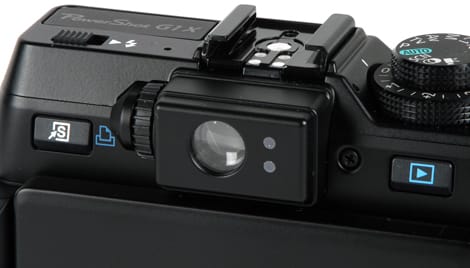

... and it has a diopter adjustment ring.
Display
{{section_header}}{{section.name}}{{/section_header}}
To complement the OVF, Nikon equips the P7100 with a big, high-res, articulating LCD screen. It weighs in at 3 inches, 921,000 pixels, and unlike the fixed monitor on the P7000, it packs a vertical hinge, too. It's bright, displays fairly well in the sun, and feels accurate and responsive to movement in real time.
It's a great screen, challenged only by the Canon G12's tilting and swiveling display, though it's smaller and has a lower resolution.

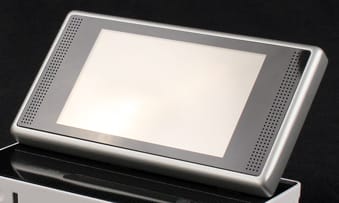
...but it turns into a nice 3-inch widescreen in playback mode.
Flash
{{section_header}}{{section.name}}{{/section_header}}
The P7100 rolls with a pop-up flash, concealed in the top-left corner of the body and unleashed with a dedicated release button, on the rear panel behind the flash. Despite its thin profile, it's a powerful light source; Nikon claims that it's effective out to nearly 30 feet. We didn't test that claim, but even if it can light up objects out to 20 feet, that's impressive.
A large handful of flash modes are available, including auto, forced flash, red-eye correction, manual flash control (selectable from 1/64 power to full power), slow synchro, and rear-curtain synchro. Flash exposure can be adjusted +/- 2 EV steps. All flash options are disabled when the flash is pushed back into the body.

The flash emitter pops up from the top of the body via a mechanical release.
Lens
{{section_header}}{{section.name}}{{/section_header}}
Like the P7000 before it, the P7100 packs a 6.0-42.6mm (28-200mm equivalent), f/2.8-5.6 lens. It's not quite flush with the body when powered off, sticks out about an inch at the wide-angle setting, and extends out to about two inches at the telephoto focal length. An automatic lens cover protects the glass from dust and scratches.

At 7.1x, the P7100's zoom range is the longest on any current high-end compact, matched only by its own predecessor, the P7000. Nikon also makes an optical teleconverter, which attaches to the lens ring and can increase the telephoto reach even further.
Battery
{{section_header}}{{section.name}}{{/section_header}}
The P7100 runs on the Nikon EN-EL14 battery, which juices up in a standalone, wall-mounted charger. We couldn't find a CIPA rating for the battery, but we snapped more than 325 shots for our review in a multitude of shooting scenarios, and never needed to recharge the camera—that's a solid number.

Memory
{{section_header}}{{section.name}}{{/section_header}}
Surprise surprise, like almost every other camera, the P7100 captures to SD/SDHC/SDXC memory cards. Cheers for standardization.

Jacks, Ports & Plugs
{{section_header}}{{section.name}}{{/section_header}}
Like most compact cameras today, the P7100 has two main ports: a mini-HDMI connection, and a micro-USB jack, which doubles as an A/V component output. Just about all of the most common reasons for connecting a camera to anything should be covered by these two ports.
In a bit of a surprise move, Nikon also includes a microphone input as well. There's nothing wrong with it, of course, but we wonder how many photographers will end up using it, considering the P7100's somewhat limited video capabilities.
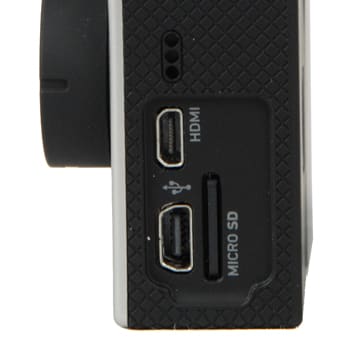
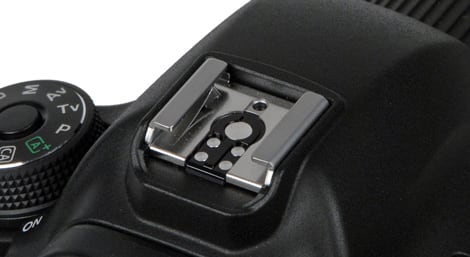
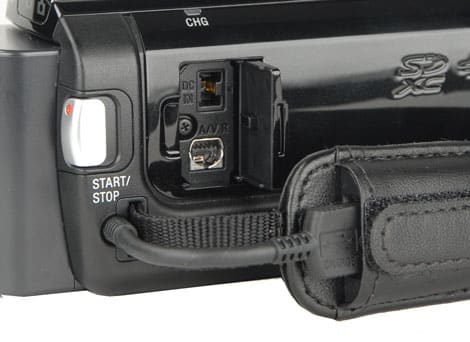
The DC-input and multi-AV port are located on the right side of the camcorder.
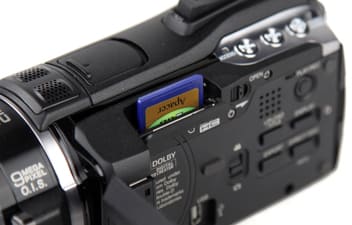
... as is the SD/SDHC card slot.
Other Hardware
{{section_header}}{{section.name}}{{/section_header}}
Teleconverter Adapter
As we mentioned in the zoom section above, the P7100 can accommodate a teleconverter accessory. The plastic ring around the lens comes off (the release button sits to the bottom-right of the lens) and the teleconverter can screw on in its place.
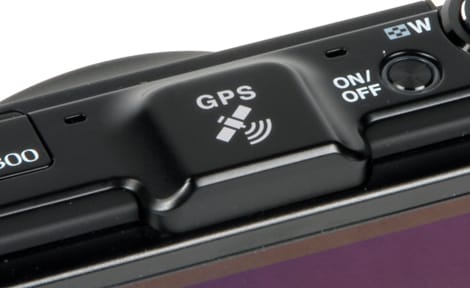
The new GPS module.
Hot Shoe
For other accessories, like an external flash or mounted microphone, the P7100 comes with a hot shoe. Most high-end compacts, including the Canon G12 and Fujifilm X10, also have this option.
Shooting Modes
{{section_header}}{{section.name}}{{/section_header}}
The P7100 comes equipped with a standard mix of automatic, preset, and manual shooting modes. There's a single, all-purpose Auto mode, where the camera takes care of all the heavy lifting. Program, Aperture Priority, Shutter Priority, and Manual modes each have a spot on the mode dial. The remainder of the wheel is rounded out with notches for effects, scene modes, movie mode, three user presets, and direct access to Low Noise Night mode.

The full mode dial is nice, but frequently rotates by accident.
Scene Modes
While the P7100 is designed for hands-on control, Nikon still included some standard preset scene modes. The usual Portrait, Landscape, and Sports settings are available, as are location specific options like Party/Indoor, Beach, Snow, Sunset, and Night Landscape. Backlighting activates an in-camera high dynamic range mode (HDR), which is useful for scenes with really bright and really dark areas in the same frame. None of the modes stick out as odd, goofy, or gimmicky.
Picture Effects
{{section_header}}{{section.name}}{{/section_header}}
Effects mode gets a little more creative, and offers some options that we haven't seen on other cameras. Some usual suspects include Painting, High Key, Low Key, Soft, Nostalgic Sepia, Defocus, and Selective Color modes. Creative monochrome offers user control over the contrast and grain effect, which is more input than we've seen in an in-camera black-and-white mode. Then there are a few chin-scratchers, like Zoom Exposure and Cross Process.
Manual Controls
{{section_header}}{{section.name}}{{/section_header}}
Nikon attempted to cram a DSLR's worth of controls onto the P7100's (relatively) compact body. There are three general command dials: a main thumb/jog dial in the top-right corner of the rear panel, which works for scrolling and as the shutter dial in manual mode; a sub-command dial around the OK button on the rear, used to scroll and navigate the menu system and doubling as a four-way pad; and a front-mounted dial, mainly used as the aperture dial in manual modes, though it's also a scroll wheel in some scenarios.
There are two other dials with fixed purposes, too. An exposure compensation dial sits next to the shutter and power switch, adjustable to +/- 3 EV stops. To the left of the hot shoe, there's a quick-menu dial. Each notch is tied to a commonly adjusted setting, like ISO, photo size and quality, white balance, bracketing, color profile settings, and custom settings. It's quicker than an all-purpose quick menu.
And then there are two assignable function buttons. Fn2, tucked next to the exposure comp dial and shutter should get most of the use. Since most of the typical adjustments are handled with the quick-menu dial, just a few less-common tools can be tied to the Fn2 button—virtual horizon, histograms, a grid, and an ND filter. Fn1 is slapped on the front panel, only comfortable to access with a right-hand ring finger. It needs to be used in conjunction with the main command dial or shutter button, so it can't stand alone, but that's typical of hotkeys on DSLRs, so experienced users should feel right at home. It accommodates more common adjustments like RAW, ISO, white balance, color profile, and many others.
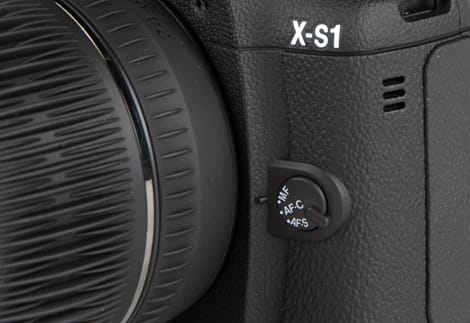
A dedicated focus-mode switch on the front panel.
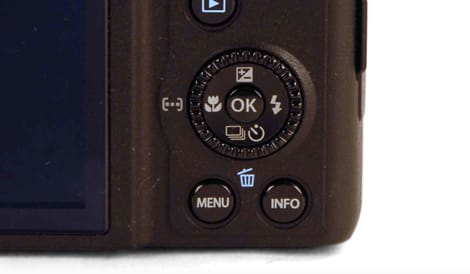
The scroll wheel surrounding the d-pad is neither awful nor perfect.
Drive/Burst Mode
{{section_header}}{{section.name}}{{/section_header}}
A few drive modes are available. Continuous mode snaps a steady stream of photos. Continuous Flash does the same thing, slowed down a bit to let the flash recharge between shots. Best Shot Selector takes a burst of shots and lets the camera decide which one is the keeper.
There is, of course, a self-timer, with options for 2 seconds and 10 seconds, smile detection, and remote control support, as well as an interval timer buried in the continuous shooting menu.
Shot to Shot ({{product.raw_scores['Shot to Shot Score']}})
Since the P7100 is built around a CCD sensor, it isn't particularly fast. We measured a consistent frame rate of 1.14fps, with an unlimited buffer. That's pokey even compared to the Canon G12, and especially next to the CMOS-based Fujifilm X10 and Canon S100.
Handling
{{section_header}}{{section.name}}{{/section_header}}
This brick of a camera is built for doin' work, not for looking pretty and feeling comfy. It's all function over form, and there's nothing approachable about it. The surplus of buttons and dials should intimidate most novice photographers. Even experienced shooters might be forgiven for thinking that Nikon crammed every button they could dream up onto the relatively compact chassis, without regard for aesthetics or handling.

Yet the setup mostly works. The grip could be bigger, but it provides enough leverage over the well-balanced body to feel fairly comfortable in hand. Most of the buttons fall in comfortable positions, aside from the front-mounted dial and Fn1 button. The viewfinder could stand to be bigger, too; the camera is already huge by compact standards, so an extra half-inch won't change much. It's bulky, but roughly the same weight as the smaller Fujifilm X10. Nikon wisely packaged it with a shoulder strap for easy toting and periods of prolonged shooting.



These dedicated buttons give you quick access to aperture and shutter speed controls.
Buttons & Dials
{{section_header}}{{section.name}}{{/section_header}}
Nikon attempted to cram a DSLR's worth of controls onto the P7100's (relatively) compact body. There are three general command dials: a main thumb/jog dial in the top-right corner of the rear panel, which works for scrolling and as the shutter dial in manual mode; a sub-command dial around the OK button on the rear, used to scroll and navigate the menu system and doubling as a four-way pad; and a front-mounted dial, mainly used as the aperture dial in manual modes, though it's also a scroll wheel in some scenarios.
Aside from the mode dial, there are two other function dials. An exposure compensation dial sits next to the shutter and power switch, adjustable to +/- 3 EV stops. To the left of the hot shoe, there's a quick-menu dial. Each notch is tied to a commonly adjusted setting, like ISO, photo size and quality, white balance, bracketing, color profile settings, and custom settings. It's quicker than an all-purpose quick menu.

And then there are two assignable function buttons. Fn2, tucked next to the exposure comp dial and shutter should get most of the use. Since most of the typical adjustments are handled with the quick-menu dial, just a few less-common tools can be tied to the Fn2 button—virtual horizon, histograms, a grid, and an ND filter. Fn1 is slapped on the front panel, only comfortable to access with a right-hand ring finger. It needs to be used in conjunction with the main command dial or shutter button, so it can't stand alone, but that's typical of hotkeys on DSLRs, so experienced users should feel right at home. It accommodates more common adjustments like RAW, ISO, white balance, color profile, and many others.
A set of more common buttons complements the function keys and dials, including a menu key, a playback key, a delete button, an auto-exposure/auto-focus lock, and a monitor/info toggle.
The buttons and dials are plastic, but sturdy and decently tactile. The command dials could be a bit tighter, and the function dials a bit looser. The shutter could use more definition between the half-pressed and fully pressed settings, but that's a matter of personal taste. The rest of the buttons have a nice feel, neither too much give nor resistance, though a few of them should stick out from the body by an additional few millimeters.

Menus
{{section_header}}{{section.name}}{{/section_header}}
Since it's so reliant on quick access and direct access keys, most users will only have to tool around in the P7100's menu system from time to time. The main menu setup is pretty typical of Nikon point-and-shoots, comprised of a tiered system with tabs for broad categories like playback, setup, and shooting.
The quick menus are where it gets interesting: Each quick menu is self contained and can tweak any adjustable setting within that parameter with just a few keystrokes. This is where most users will spend most of their time.
Manual & Learning
{{section_header}}{{section.name}}{{/section_header}}
Though it's a $500 camera, Nikon only includes a basic quick-start guide in the P7100. The booklet looks thick, but that's because four different language versions are crammed into one edition. The full manual is included in PDF format on a CD ROM.
Fujifilm FinePix X10 Comparison
The Canon G12 and the Nikon P7000 were both announced in mid-2010. Both aimed to please the same type of photographer, and both delivered great image quality. But the G12 became the more popular camera among buyers and critics alike—the P7000 was just too sluggish for most , especially with the faster, nearly identical G12 available for the same price.
With the P7100, Nikon just added an extra dial to the P7000's chassis and boosted performance a bit. So now, a year later, Nikon finally caught up to the G12 (they're lucky that Canon didn't see a reason to launch a G13 this year).
Pound for pound, the G12 and P7100 are about as evenly matched as two cameras can get. They're separated by less than one-third of a percentage point in our final rankings—functionally the same. The P7100 takes slightly cleaner, sharper images, while the G12 offers a better interface. But these two cameras are slight variations on the same theme, so take your pick.
Canon PowerShot S100 Comparison
Nikon spent the last year catching up to the Canon G12, and Canon took a break for this cycle. Meanwhile, Fujifilm cooked up their own high-class compact in the X10. It takes some cues from its chief rivals, but stands apart from the G12 and P7100 by incorporating striking, rangefinder-esque design elements and more versatile imaging technology.
Fuji's contender is quicker and easier to handle than the P7100, with a much brighter f/2.0-2.8 lens. It's better suited for street shooting, general snapshots, and especially indoor and dimly lit scenes. Both cameras can capture equally great photos in most settings, but the X10 doesn't demand as much attention and hands-on fiddling from the user to achieve the same quality.
The P7100's longer zoom and surplus of direct-access controls and dials are great, and it's at least $100 cheaper than the X10 at the moment. Those are great reasons to buy, but the added bulk and laggy performance will counter-balance any benefits for a lot of users. It's a camera best suited for nature and some landscape photography, and it really shines when it's mounted on a tripod.
Our overall pick in this matchup is the X10. It has its share of issues—the typical firmware-related maladies that Fujifilm never seems to perfect—but it should make more photographers happy more of the time than the P7100.
COMP 3
High-end compacts like the Nikon P7100 tend to be built according to the more-is-more school of design, but the Canon S100 is more like a simple point-and-shoot with a few extra features. It's small, made of plastic, includes just a few direct-access controls (aside from an excellent lens ring), and has no viewfinder or hot shoe.
Despite those perceived shortcomings, the S100 and its predecessors have also been the best-selling and most widely praised high-end compacts of the past few years. Chalk it up to the fast lens, pocketable profile, and generally lower price tag than the G and P7 series.
These two cameras serve slightly different purposes, but the S100 is bound to please more shooters than the P7100. The Canon's bright f/2.0 maximum aperture makes for more reliable indoor and low-light shooting, especially combined with the extra-sensitive CMOS chip that Canon included in this model. Performance is much zippier, and we measured better image quality scores across the board, except for color reproduction.
The P7100 does offer more direct-access control and a longer reach, but our educated guess is that portability and the ability to capture good-looking shots in about any setting is going to win the S100 many more fans than the P7100, as it should.
Conclusion
The Nikon P7100 is on a mission to be everything that photo enthusiasts have come to expect from a high-end compact: A bigger sensor than most compacts, an optical viewfinder, heaps of dials and direct-access controls, and the option to shoot in RAW format.
As it should, those individual factors all add up to a great camera. Image quality is excellent, with beautifully rendered details and accurate colors. Aside from Nikon's bizarre choice to disable distortion control by default (and completely exclude it from Auto mode), and soft, desaturated results at the height of the ISO range, we can't find much to complain about. Manual control is plentiful and well-integrated, contributing to what can be a great overall user experience. Performance speed isn't too shabby either, and a notable improvement over last year's sluggish P7000.
But (betcha saw that one coming) the high-end compact segment is incredibly competitive. Each model that we've reviewed sits in our current Top 10 point-and-shoots, and deserves whatever audience it attracts. The P7100 probably won't appeal to as many potential buyers as, say, the Fujifilm X10 or Canon S100.
A major factor is the P7100's tenuous grasp on low-light shooting, or even just regular indoor and artificially lit conditions, for that matter. It does fine in those settings, especially with some planning, but it can't grab clear, clean shots as effortlessly as X10 or S100, both of which have faster f/2.0 lenses and light-hungry CMOS sensors. For photographers with spontaneous shooting habits, the P7100 is not the best bet.
It is, however, a great camera for patient photographers. It's capable of shooting fantastic outdoor photos, but it needs a little extra attention to detail and hands-on care to do it. That's no problem for nature, landscape, and long-exposure photographers—anyone used to propping his or her camera on a tripod, carefully framing the shot and selecting the right settings, and waiting for the right moment to shoot.
To be clear, the Nikon P7100 stands on its own merits. Its score—8.1 at the time of publication, puts it a hair ahead of the Canon G12 and Olympus XZ-1, and not far at all behind the Fujifilm X10 or Canon S100—should make that obvious. But if Nikon can boost the next iteration's speed and give it a faster lens, it may well be sitting at the top of next year's heap.
Photo Gallery
{{photo_gallery "Front Photo", "Back Photo", "Sides Photo", "Top Photo", "Bottom Photo", "Lens Photo", "Flash Photo", "EVF Photo 1", "EVF Photo 2", "LCD Photo 1", "LCD Photo 2", "Media Photo", "Modes Photo", "Manual Controls Photo", "Manual Controls Photo 2", "Other Controls", "Buttons 1", "Buttons 2", "Other Hardware Photo", "Battery Photo", "Ports Photo 1", "Ports Photo 2", "Ports Photo 3", "Ports Photo 4", "Handling Photo 1", "Handling Photo 2", "Handling Photo 3", "Box Photo"}}
Meet the tester
Liam manages features and news coverage for Reviewed.com. Formerly the editor of the DigitalAdvisor network, he's covered cameras, TVs, personal electronics, and (recently) appliances. He's a native Bostonian and has played in metal bands you've never heard of.
Checking our work.
Our team is here to help you buy the best stuff and love what you own. Our writers, editors, and experts obsess over the products we cover to make sure you're confident and satisfied. Have a different opinion about something we recommend? Email us and we'll compare notes.
Shoot us an email

